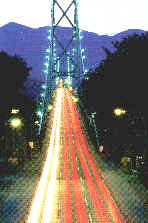|
|
Across Burrard Inlet and at either end stands two massive bridges, linking Vancouver to North Share. At the West end guarding the entrance to the natural harbor stands the First Narrows or Lion’s Gate Bridge. To the East is Second Narrow Bridge. Together these structures from an iron bracket around busy waters of inlet carrying constant stream of traffic to and from municipalities of North and West Vancouver and district of North Vancouver.
Communities of North shore, North and West Vancouver have very different characters. West Vancouver, because of its rugged geography has not been industrially developed and is largely a residential community. Its residents commute to work in other parts of Vancouver, or are employed in service industries in the district. West Vancouver have some lovely shopping districts and the area itself is remarkable for the amount of greenery. The residents take great pride in maintaining both private and public areas in accordance with this natural beauty.
North Vancouver has, from its origins as mill town, developed along industrial lines. During Depression, North‘s revenue was cut so drastically, that the city all but stopped functioning. But with the outbreak of World War II , ship-building facilities took on great importance. With the influx of workers for shipyards, homes had to be built and since that time, North Vancouver has continued its expansion. As well as its substantial shipbuilding facilities, the area has light manufacturing and plays a large part in activities of Port of Vancouver, with the shipping of grain, coal and lumber.
Topography of North Shore is spectacular and some of favorite sports for visitors are here. Many residents live high up on mountain-side and enjoy stimulating view of . There are three main mountains to visit and the better known of these is Grouse Mountain with its famous Sky ride and panoramic view from the top. To the East of Grouse Mountain is Mount Seymour, which as well as being a Provincial park, is also a popular skiing and hiking area. To the West is Cypress Park, another skiing and hiking area, but also a popular area for cross-county skier as well as Alpine skiers. Both Mount Seymour and Cypress Park can be reached by automobile along well-maintained roads.
For those inclined to hiking, or just walking, Lighthouse Park offers a variety of terrain within its 90-acres area. Its forests, which is preserved in its natural states, is a rare example of primeval forest, which once covered the entire area.
Further along the coast, at Horseshoe Bay, are ferry terminals. Here B.C. Ferries come and go on their way to Bowen Island, Sunshine Coast and Vancouver Island. Ferry Service has had a long history in West Vancouver, dating from 1866, with a single boat. By 1908, there were four vessels servicing the area and in 1961, provincial government took over ferries.
Another attraction on North Shore is Capilano Canyon. Capilano Canyon boasts a suspension bridge, which has existed as a tourist attraction since about 1904. This 450 foot footbridge hangs more than 200 feet above Capilano River. Further along Canyon and just bellow Cleveland Dam, which supplies a large portion of water for Vancouver, is fish hatchery. Here, curious visitor can learn at first hand the life cycle of Pacific Salmon.
Vancouver has recently instituted a new transportation system to North Shore (1999). The bright orange sea bus caries foot passengers and cyclists regularly from central downtown to the foot of Lonsdale in North Vancouver, a trip which allows visitor and commuter alike to enjoy the scenic beauty of the harbor without the worry of traffic.
Visions of North Shore:
Ambleside Park; Carisbrooke Park; Gates Park; Dundarave Pier; Grand Boulevard; Horseshoe Bay Park; John Lawson Park; Lower Lonsdale; Lynn Valley Park; Maplewood Farm; Moodyville Park; Mosquito Creek

|
|

